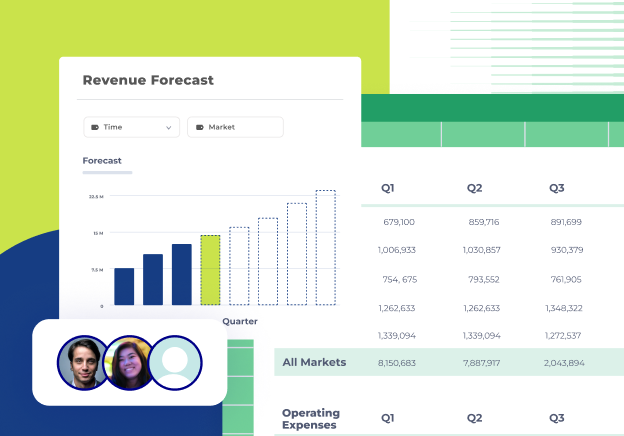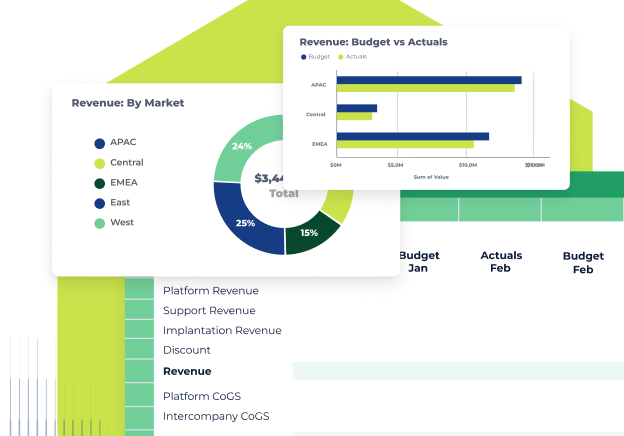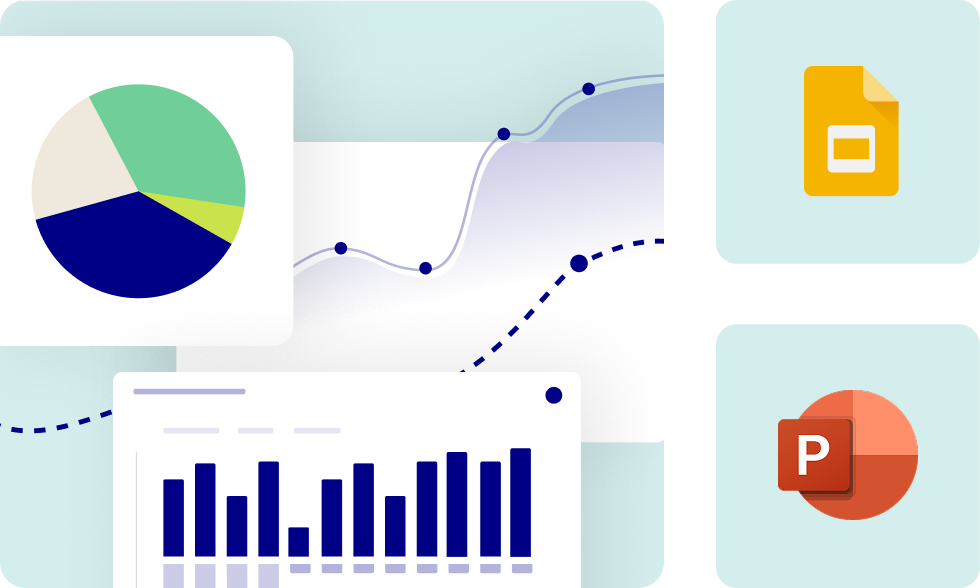What's inside this Google Slides board deck template
Board meetings are stressful, especially when preparing that infamous quarterly meeting deck as part of your strategic financial planning. This board deck template aims to make this process a little bit easier on busy CFOs and CEOs. In it, you'll find 40+ Google Slides to set you up for success. These include slides on:
Company initiatives and status updates
A high-level recap of company initiatives and their status, our slides can be used to frame where your company currently stands. Share what’s working (recent wins, milestones) and what’s not (issues that need solving, long-term strategy concerns). Highlighting these updates provides context, keeps the board aligned on priorities, and ensures the meeting focuses on what’s most important.
Updates by departments
Including updates from departments adds depth to your board deck. It helps the board see how each team contributes to the company’s overall performance and strategic goals. These updates also provide an opportunity to address specific challenges and celebrate wins across the organization.
Some board deck examples by department:
- Marketing teams share metrics on campaign performance, lead generation, and brand awareness.
- Sales teams highlight pipeline growth strategies, deal closures, and regional performance trends.
- People teams report on hiring progress, retention rates, and updates on employee engagement initiatives.
Core key performance indicators (KPIs)
Core KPIs are the heart of the board deck. They give the board a clear picture of your company’s performance and its ability to meet objectives. You can use our slide templates to showcase your company’s core KPIs, such as ARR, monthly burn, customer acquisition costs, and churn rates, in a comprehensive way. Sharing these metrics gives board members the chance to identify trends, ask targeted questions, and provide actionable feedback.
Financial summary information
The financial summary—budget vs. actuals, balance sheet, cash flow—gives the board a clear understanding of your company’s financial health. It’s a critical section of the deck because it sets the tone for discussions about strategy, investments, and risk. With our financial summary slide templates, you’ll be able to provide the context necessary for the board to focus on forward-looking growth opportunities.
Appendix/databook examples
An appendix or databook provides the nitty-gritty details that support the main points of your deck. It offers board members the opportunity to explore key data and demand forecasting without cluttering the main presentation. Our slide templates guide you through the process of what to include based on your objectives, such as detailed financial reports, key operational metrics, or scenario analyses tied to strategic decisions.
But the deck is only the beginning. Explore our tips and tricks below to ensure that your quarterly board presentation, along with your team and CEO, puts their best foot forward.
What is a board meeting presentation deck?
A board meeting presentation deck is a structured slide presentation used to brief a company’s board of directors on the business’s performance, priorities, and strategic direction. It typically accompanies a quarterly or annual board meeting and serves as the primary framework for discussion.
A strong board deck:
- Summarizes company performance: Financial results, KPIs, growth metrics, and notable wins or challenges
- Highlights strategic initiatives: Progress on major projects, product updates, key hires, and market developments
- Surfaces risks and needs: Obstacles the company is facing, decisions required from the board, and areas where leadership needs guidance or approval
- Provides forward-looking plans: Goals for the next quarter, forecasts, and opportunities the company plans to pursue
Following the presentation, the board deck becomes a reference point for decisions, priorities, and follow-up actions. It’s used throughout the quarter to keep leadership aligned and accountable until the next update.
Quarterly planning vs. annual planning
Quarterly planning breaks the year into focused 90-day cycles, detailing the specific projects, revenue targets, hiring plans, and KPI improvements that need to happen in the near term. It’s tactical and adaptive, allowing teams to respond quickly to performance insights or shifting market conditions.
Annual planning, on the other hand, sets the company’s broader strategic direction. It establishes long-term goals, budgets, investment priorities, and major initiatives like product launches or market expansions and provides the overarching framework that quarterly plans ladder up to.
Knowing which to prioritize depends on where your organization is in its growth and what it needs most: agility and consistent course-correction (quarterly) or long-range vision and resource allocation (annual).
Key sections of a board meeting deck
Every company’s board reporting and meeting decks look a little different, but most follow a consistent flow that guides the conversation so nothing important gets overlooked. Here are the key sections to include:
- Company update: Provide a high-level view of what’s working, what’s not, major wins, milestones, threats, and any issues that require visibility.
Example: If a new competitor has been gaining traction, you might begin by outlining shifts in market dynamics and describing how customers are reacting. Including this update helps the board understand why resources may need to shift in the upcoming quarter, especially if core positioning is being refined. - Updates by department: Share short, structured updates from Sales, Marketing, People, Product, Engineering, or other functions. Cover what went well, what didn’t, and what each team is focused on next.
Example: The Head of Marketing might share the results of a targeted campaign that significantly improved mid-market pipeline quality. Breaking down what worked—the messaging, the channels, the audience—helps the board understand why the team is proposing to expand that strategy next quarter. - Key discussion: Dedicate time to any strategic topics where board input is needed, such as sales capacity, product roadmap decisions, fundraising plans, or talent retention.
Example: When a key feature is behind schedule due to engineering turnover, leadership might outline how this delay impacts downstream goals. Presenting the root cause and proposing specific support, such as approval for additional hiring, helps the board understand why intervention is needed now. - Financial summary: Walk through the company’s financial health—revenue, margin, cash, expenses, budget vs. actuals, and progress against plan.
Example: A founder could highlight that revenue came in slightly below expectations due to slower enterprise cycles, then show why this isn’t an indicator of weakening demand. Walking through the underlying drivers behind the variance helps the board see the difference between timing issues and true performance concerns. - Databook & appendix: Include deeper charts and analyses for board members who want more context, such as pipeline trends, retention metrics, headcount data, cash flow detail, or unit economics.
Example: The team might include deeper analyses—usage cohorts, funnel conversion breakdowns, or competitive pricing comparisons—to support earlier discussions. These materials let board members explore the underlying data behind the team’s recommendations.
Key questions to cover in your quarterly board presentation
The ability to address key financial questions not only provides transparency but also forms the foundation for strategic decision-making. Some important questions your board deck presentation should cover include:
- What were the quarter's financial results, and do the financial reports indicate significant changes in revenue, expenses, or profitability compared to the previous quarter and the same period last year?
- How closely did the actual results align with the key budget assumptions, and what major variances occurred, along with their underlying reasons?
- How is the company's cash flow and liquidity being managed, including any notable changes in working capital or cash conversion cycles?
- What progress has been made on previous quarters' strategic initiatives, and are there any adjustments to the plan based on market conditions or internal factors?
- What are the key risks facing the company, and how is the organization mitigating them, with any notable changes in the risk landscape since the last board meeting?
- What is the outlook for the next quarter and the remainder of the fiscal year, including any changes to previous guidance and the factors that may impact future performance?
How to set up the ultimate board meeting presentation deck
Preparing a board deck presentation doesn’t have to be overwhelming. With a clear structure and thoughtful preparation, you can create a deck that informs and engages your board effectively. Here’s how.
1. Start with a clear timeline
You and your CEO don't want to be scrambling together a deck and talk track last minute for the board meeting. To stay ahead of the curve, here's our recommended timeline when planning for the board meeting:
- 1 month out: The CEO and CFO share key topics with board members and get a pulse on 2-3 major strategic topics.
- 3-4 weeks out: The CEO shares the initial agenda and deck skeleton with the executive team.
- 2 weeks out: The CEO and CFO consolidate and review slides from the cross-departmental executive teams.
- 7-10 days out: Practice the full run of show with your executive team. Fill in any gaps that come from that meeting.
- 3-5 days out: The CEO shares the finalized deck with board members.
- Week of: The CEO calls each board member to address any outstanding questions.
- Day of: Take a deep breath—you've done the hard work.
2. Focus on the details
First off, it’s important to include specific KPIs and metrics from the previous period to give the board a clear picture of performance. Metrics like revenue growth, gross margin, and customer acquisition costs provide measurable insights that steer discussions and decisions. Keeping these metrics consistent from meeting to meeting allows the board to track trends over time and assess the impact of strategies.
Tip: Always share context on the numbers. Is $1M good, bad, or right on track? Use simple visual cues—like red, yellow, and green status markers—to instantly communicate performance.
3. But take a step back
While details matter, don’t forget to zoom out and address the big picture. Highlight major developments, such as launching a new product or entering a new market, and explain how they align with your company’s overall strategy.
Make sure to also address any challenges, such as supply chain disruptions or increased competition. Providing the board with a broader context gives them the chance to participate in meaningful, forward-looking discussions.
Tip: Highlight where you need support or decisions. Make it obvious which topics require board action—budget approvals, hiring plans, strategic choices, or compensation items.
4. Show, don't tell
Visuals make board deck presentations more engaging and much easier to understand. Instead of overwhelming the board with raw data, use charts, graphs, or infographics to illustrate trends and comparisons. A simple bar chart showing revenue growth by quarter can convey more in seconds than a table full of numbers or walls of text.
Tip: Start with high-level insights first, then be ready to drill down when asked. Don’t force every detail into a single slide—leave room for questions.
5. Create a clear meeting structure
A well-structured meeting keeps everyone on track and ensures key points are covered. Start your deck with an agenda slide that outlines the floww of the meeting, followed by company updates, financial performance, and strategic priorities. You might allocate 15 minutes to reviewing KPIs, 20 minutes to department updates, and 25 minutes to discussing strategic initiatives, leaving time for some Q&Q at the end.
Tip: Include a clear list of action items. Summarize who owns what after the meeting so expectations are unmistakable and follow-through is easy to track.
6. Share details early
Send the board materials a few days before the meeting so members have time to review and prepare. This gives them space to study the data, come up with questions, and think about opportunities or challenges they want to discuss. Sharing the deck early also sets a professional tone, showing the board you value their time and input.
Tip: Ask for feedback in advance. A quick note asking what they want to focus on helps you tailor the discussion and avoid unproductive tangents.
How to present a new plan to the board
Looking to get the buy-in of your board on a new plan? Make sure you have a compelling story to tell.
Short-term vs. long-term
Share the short term through the long term. An annual plan should be shown alongside a long term (3 or more years) plan, and broken down by quarter. Don’t forget to sum the years appropriately so the board can clearly identify the timeline.
Compare scenarios
Increase your chance of approval by showcasing multiple versions of your plans, especially best case, worst case, and most likely. Include visual aids, such as charts and tables, so board members can grasp your vision at a glance. This allows reviewers to see the effect of risk vs. reward in a compelling way.
Compare versions
If your board deck presentation is an update to a prior plan, show where and how it differs across each version so everyone sees what’s changing. Focus on highlighting key shifts since the plan was implemented—both wins and losses. Guide board members through changes made that are going well, any course corrections that have taken place, and lingering problems that need to be addressed. (Always include potential solutions in your board reporting.)
Common pitfalls to avoid during a board meeting
Now that you have a strong foundation, let's dig into what you should MAJORLY avoid doing during any board meeting:
Don’t wait until the last minute. Board prep should start about a month before the board meeting takes place.
Don’t create too much new work for the board meeting. Design a set of standard KPI slides and use them for managing your business and reporting out to the board.
Don’t forget to practice your mental math. If you don’t know the answer to an on-the-spot question, you can often share parts of it (e.g., it’s roughly 20% of last quarter’s number).
Don’t be too precise. Accuracy is good, but too much precision can dilute the message. Know the board's materiality threshold and report on it (e.g., $millions vs. $thousands).
Grab your free quarterly board deck template for Google Slides
Our free quarterly board deck template is designed to simplify your presentation, offering a user-friendly framework for clear, professional, and impactful communication with the board.
Enter your business email to the right and download the template to get started immediately.
Board meeting deck FAQs
What should an overall quarterly board meeting structure look like?
A quarterly board meeting should kick off with a brief company update—wins, milestones, and key issues—then move into short updates from each department. After functional highlights, focus the conversation on any strategic topics that need board input. Close with a clear financial review (revenue, cash, margins, and budget vs. actuals), followed by an open Q&A, next steps, and a brief closed session if needed.
What should take priority in creating a board deck?
When creating a board deck, your top priority should be clearly highlighting performance, challenges, and upcoming opportunities before diving into slide-by-slide detail. The board wants to quickly understand what’s working, what’s not, and where leadership needs support. Once those headline insights are established, the rest of the deck can provide the context, data, and narrative that back them up.
Do startups need board presentation meeting decks?
Yes, startups benefit greatly from creating board decks. Even a simple version helps founders organize their updates, focus the discussion, and highlight the progress and challenges that matter most. It also gives investors the clarity they need to provide useful guidance and ensures everyone shows up aligned on priorities and next steps.
How long does quarterly planning take?
How long quarterly planning takes depends on your company’s size, structure, and the number of teams involved. For some organizations, a focused half-day session is enough to review progress, align on priorities, and set the next quarter’s goals. Larger companies (or teams with more cross-functional dependencies—may need a full day or even up to two days to work through reviews, discussion blocks, and long-term planning. The more preparation done ahead of time, the shorter and more efficient the planning sessions will be.


.png)









.png)
